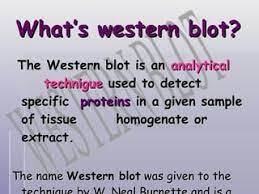Table of Contents
Western Blot is a widely used protein analysis method. After the protein extract is obtained from the sample, it is separated by gel electrophoresis and transferred to the antibody detection target to analyze the expression of the target protein, which is the basic process of the western blot method.
The following is a brief introduction to the different steps. For more detailed experimental details, please refer to other links.
1. Separation
Colloid electrophoresis (Polyacrylamide gel electrophoresis, PAGE) uses electric field and film structure to separate the mixture samples in the colloid, and then separates the target protein from the extract. The effect of film separation depends on whether the appropriate colloid, buffer and the state of the sample itself are used.
1-1. Film and Running buffer
The film itself is interwoven by Bis/acrylamide through the catalytic reaction of APS and TEMED. Different components and different acrylamide ratios can be used to cast films with different characteristics to separate target proteins with different characteristics. The reaction schematic diagram is as follows.
There are two main sources of film: Handcast gel and Precast gel; Acrylamide ratio composition can be divided into linear (Linear) and gradient (Gradient), different acrylamide concentrations can be used for different molecular weights (Molecular Weight) The range has the best degree of separation; as far as the gel structure is concerned, there are Continuous gel composed of a single gel and Discontinuous gel formed by stacking multiple gels. The comparison table and schematic diagram are as follows. The choice of rubber running buffer is related to the chemical composition of the film. Only the matching buffer can achieve the best separation effect and make the bands sharp and clear, and also avoid excessive resistance and insufficient electrolyte in the rubber running system.
1-2. Sample preparation
Before separating the protein extract, it needs to be treated with sample buffer (Sample buffer). According to the experimental requirements, it can be divided into the original state (Native condition) that maintains the original configuration of the protein (Native condition), the denatured state (Denature condition) that destroys the hydrophobic structure after being treated with anionic surfactant (Anionic detergent), and the addition of a reducing agent (Reducing agent) and heating. The reducing state (Reducing condition) completely destroys the protein configuration. The sample buffer contains dyes such as Bromophenol blue or Coomassie Blue to allow the user to visualize the sample location.
1-3. Glue running system installation and glue running
Assemble the film and the corresponding buffer into a suitable running tank (Running Tank), and select a power supply with sufficient power (Power supply), see the schematic diagram below.
Add the processed sample into the sample well of the film, be sure to add the sample vertically and stably and confirm that the sample sinks to the bottom of the well. If you buy various brands of glue or self-casting glue reagent kits, since the optimized rubber running conditions of each company are not the same, please be sure to refer to the official information on each company’s official website for testing.
The degree of gel running is based on running the entire film as completely as possible but the sample dye (Dye front) does not separate from the film. It is also recommended to use a suitable protein standard solution (Protein ladder) to roughly estimate the molecular weight of the protein to avoid incomplete separation of protein samples. Or the target protein is detached from the colloid.
2. Transferring
After the sample is separated, the protein in the colloid is transferred to the transfer membrane (Transfer membrane) by using an electric field, which not only makes the experimental operation easier, but also makes the antibody (Antibody) have better recognition ability. There are two main types of commonly used transfer membranes: nitrocellulose (Nitrocellulose, NC) and polyvinylidene difluoride (Polyvinylidene difluoride, PVDF). Both have a high affinity for proteins (Protein-binding affinity), usually PVDF has a higher binding capacity (Binding capacity) than NC, but PVDF membranes need to be infiltrated with methanol or ethanol before use, while NC membranes are more fragile. The pore size is mainly 0.2 mm for small molecular weight (£ 20 kDa) and 0.45 mm for general use.
There are three types of transfer systems: wet (Wet), semi-dry (Semi-dry) and dry (Dry). The wet type soaks the transfer module (Transfer sandwich) in the buffer solution. In addition, different transfer buffers (Transfer buffer) can be used according to different types of films to achieve the best transfer effect, and if the experiment needs to transfer for a long time, the transfer system can also be placed in a cold room or ice bath. The semi-dry type only uses a small amount of buffer to wet the transfer sandwich, and uses a large-area electrode plate for transfer. The transfer time is shorter than that of the wet type, but it is not suitable for large molecular weight protein transfer. The dry type is to use special materials and electrode sheets to cooperate with designated equipment to complete the transfer in a short time and does not need to prepare transfer buffer.
3. Detection
3-1. Blocking buffer
Soak the transferred membrane in the blocking buffer to fill the gap of the transferred membrane to avoid non-specific binding (Non-specific binding) caused by the subsequent antibody being absorbed by the transferred membrane. Shake slowly during the soaking process In order to facilitate the uniform sealing of the transfer film. Commonly used blocking buffers include 2-5% skim milk (Skim milk), 2-3% bovine serum albumin (BSA), 1% casein (Casein) and phosphate buffer containing surfactant ( Phosphate-buffered saline with Tween-20, PBST) or Tris-buffered saline with Tween-20, TBST). Major brands also provide ready-to-use (Ready-to-use) formula blocking solutions and protein-free blocking buffers, allowing users to choose suitable products according to the characteristics of the target protein.
3-2. Wash buffer
Since the transfer membrane will be converted and incubated (Incubate) in various immunochemical reagents (Immunochemical reagents), washing is required between each step to remove excess reagents, thereby reducing non-specific signals and background signals. Commonly used washing buffers are Phosphate-buffered saline (PBS) or Tris-buffered saline (TBS), add 0.05% – 0.5% surfactant such as polysorbate -20 (Tween-20) to remove non-specific binding. The main time points for using the wash buffer are between the primary and secondary antibody incubations and after the secondary antibody incubation. The usual procedure is to wash three times for 5 – 10 minutes each.
3-3. Primary antibody
The blocked transfer membrane can be moved to the target protein antibody with specific-binding affinity for binding. When selecting an antibody, special attention should be paid to the fact that the antibody’s Species Reactivity must be the same as the source of the sample in order to have a stable and specific binding ability. In addition, it is also recommended to select products that have been approved by the original factory and can be used in Western blot method, and refer to the recommended concentration provided by the official or refer to the concentration used in academic papers to prepare in the blocking solution.
3-4. Secondary antibody
If the labeled primary antibody is directly used for signal detection, it will be difficult to detect and increase the signal noise ratio (Signal noise ratio, SNR) due to insufficient signal. Therefore, the label is connected to the secondary antibody to amplify the signal and then Improved result presentation, as shown in the schematic diagram below.
Therefore, the transfer membrane that has been treated with the primary antibody and completed the washing process is transferred to the secondary antibody corresponding to the species of the primary antibody to bind to it for subsequent detection. Commonly used secondary antibody markers are horseradish peroxidase (Horseradish peroxidase, HRP), alkaline phosphatase (Alkaline phosphatase, AP) or fluorescent substances.
3-5. Coloration
At present, there are two main coloring methods of western blot method: Chemiluminescent and Fluorescent.
If the luminescence system is used, the secondary antibody is attached to HRP or AP enzyme. After the secondary antibody is washed, a specific substrate (Substrate) is used to react with the enzyme to generate chemical luminescence, and then X-ray film (X-ray film) or image capture system for cold light detection.
If the secondary antibody connected to the fluorescent substance is selected, the step of substrate reaction can be omitted, but the fluorescent signal acquisition equipment is required to obtain the experimental results.




